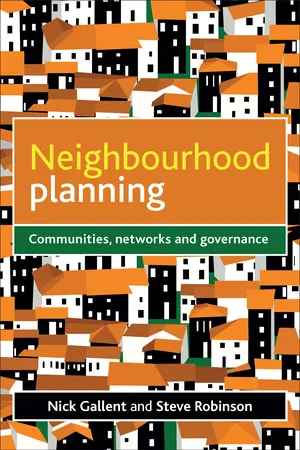
- 224 pages
- English
- PDF
- Available on iOS & Android
About this book
Neighbourhood planning offers a critical analysis of community-based planning activity in England, framed within a broader view of collaborative rationality and its limits. From the recent experience of drawing up parish plans, and attempts to connect these to formal policy frameworks, it identifies lessons for future planning at the neighbourhood scale. It is not a manual on community planning practice, nor does it provide a formula for producing parish or neighbourhood plans. But in the context of the latest 'localism' agenda in England it, first, examines the potential contribution of neighbourhood planning to building a 'collaborative democracy' and, second, asks how much movement towards genuine local partnership, and consensus around development decisions, can be achieved through the rescaling of 'statutory' planning as opposed to expending greater effort locally on building stronger relationships, and generating trust, between 'people and planning'
Frequently asked questions
- Essential is ideal for learners and professionals who enjoy exploring a wide range of subjects. Access the Essential Library with 800,000+ trusted titles and best-sellers across business, personal growth, and the humanities. Includes unlimited reading time and Standard Read Aloud voice.
- Complete: Perfect for advanced learners and researchers needing full, unrestricted access. Unlock 1.4M+ books across hundreds of subjects, including academic and specialized titles. The Complete Plan also includes advanced features like Premium Read Aloud and Research Assistant.
Please note we cannot support devices running on iOS 13 and Android 7 or earlier. Learn more about using the app.
Information
Table of contents
- Neighbourhood planning
- Contents
- List of figures, images and table
- Abbreviations
- Acknowledgements
- Authors’ note
- Part One: Democracy, planning and localism
- 1. Introduction
- 2. Democratic renewal, planning and housing growth in England
- 3. Localism and its antecedents
- 4. Community-based planning and plans
- Part Two: Capacity building and community-based planning
- 5. Ashford and its strategic planning context
- 6. Power, capacity and collaborative planning
- 7. Community dynamics and planning
- 8. Capacity building and outreach
- Part Three: The interface with policy actors
- 9. Connectivity at the policy–community interface
- 10. Working with local government
- 11. Working through intermediaries
- 12. Community-based plans
- 13. Planning’s critical interface
- Part Four: Neighbourhood planning, leadership and democratic renewal
- 14. Responsibility and responsiveness: lessons from parish planning
- 15. Conclusions
- References
- Index